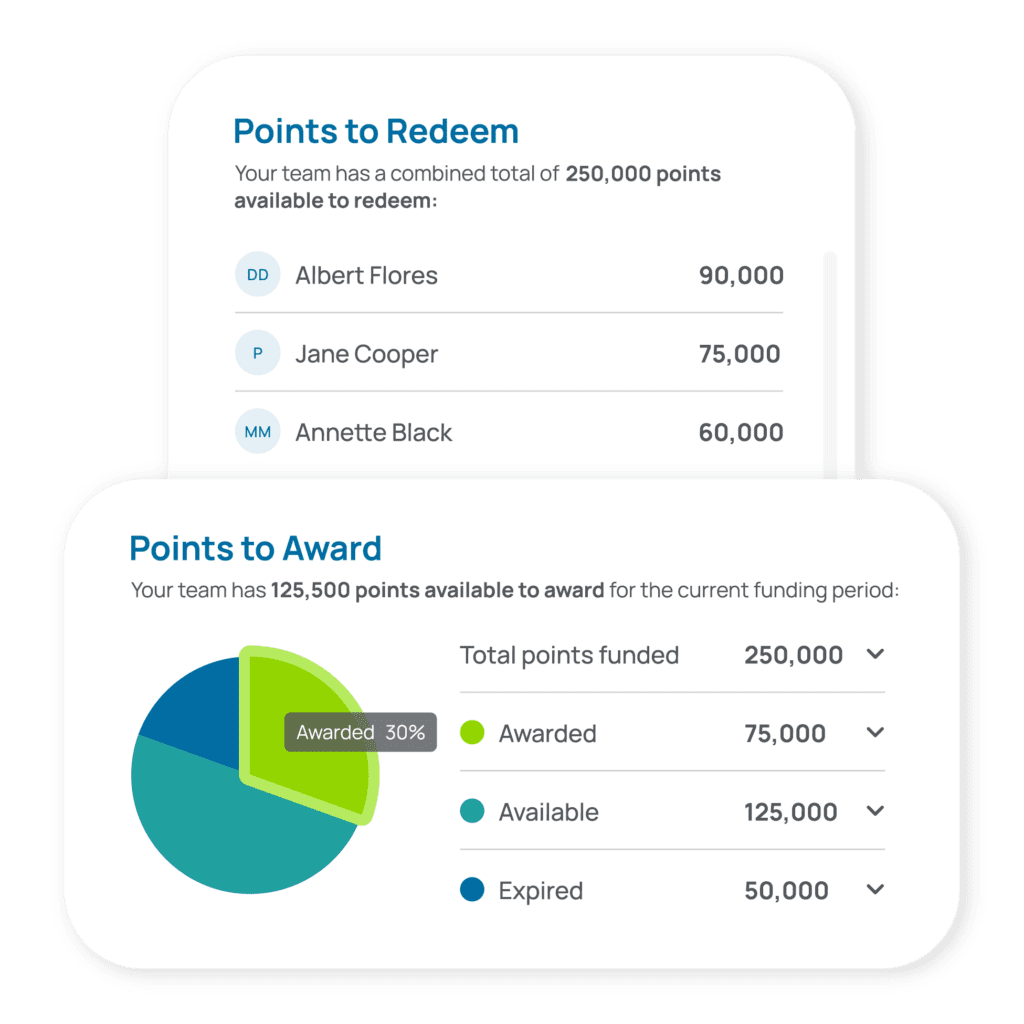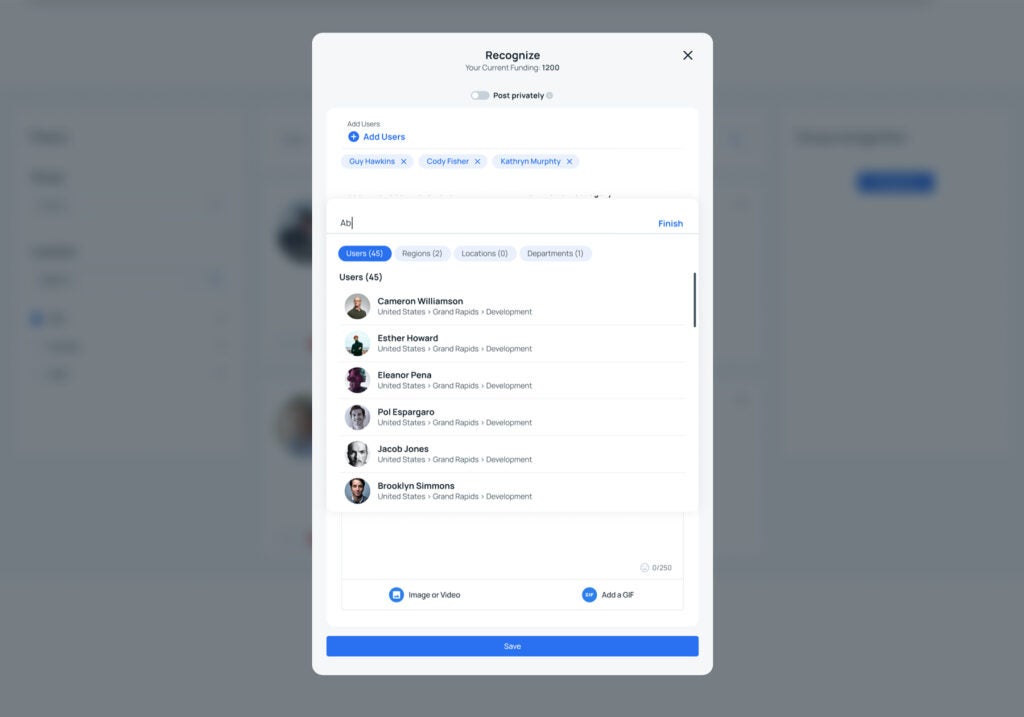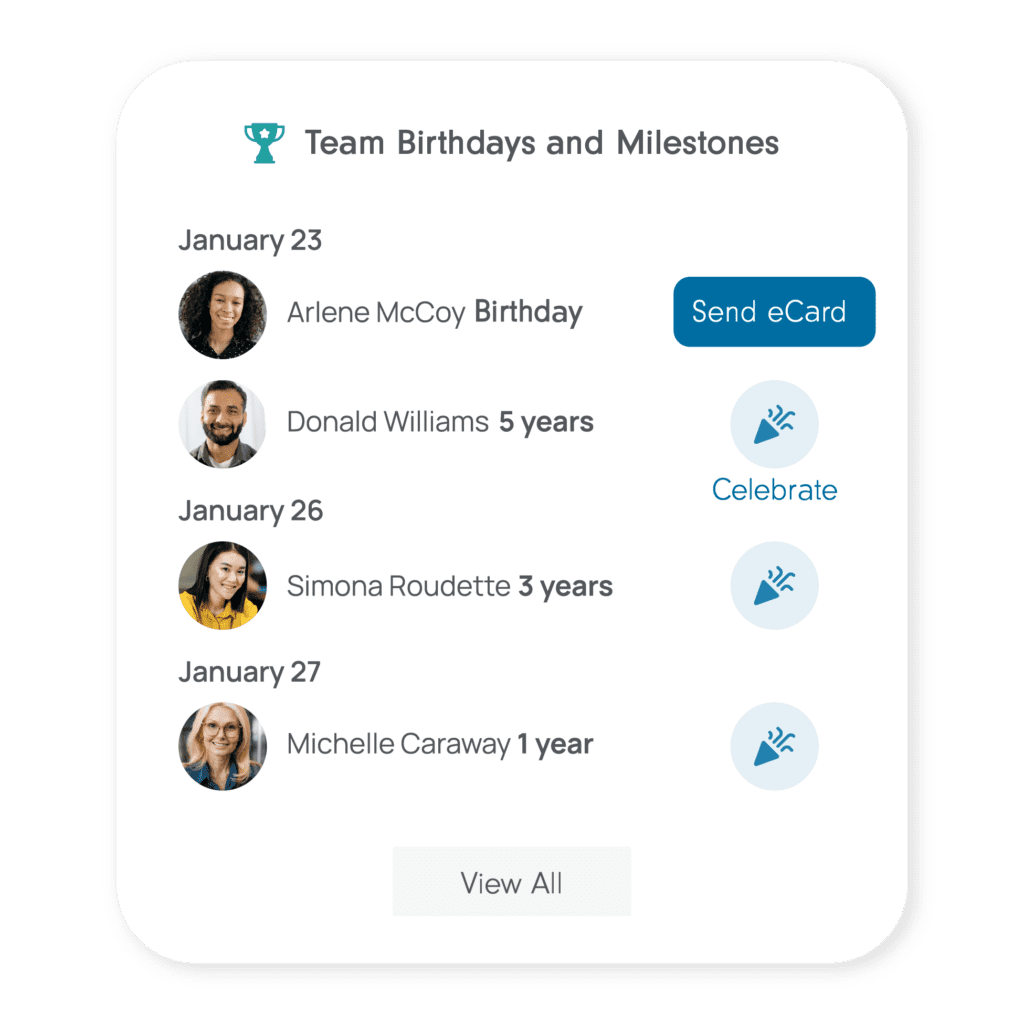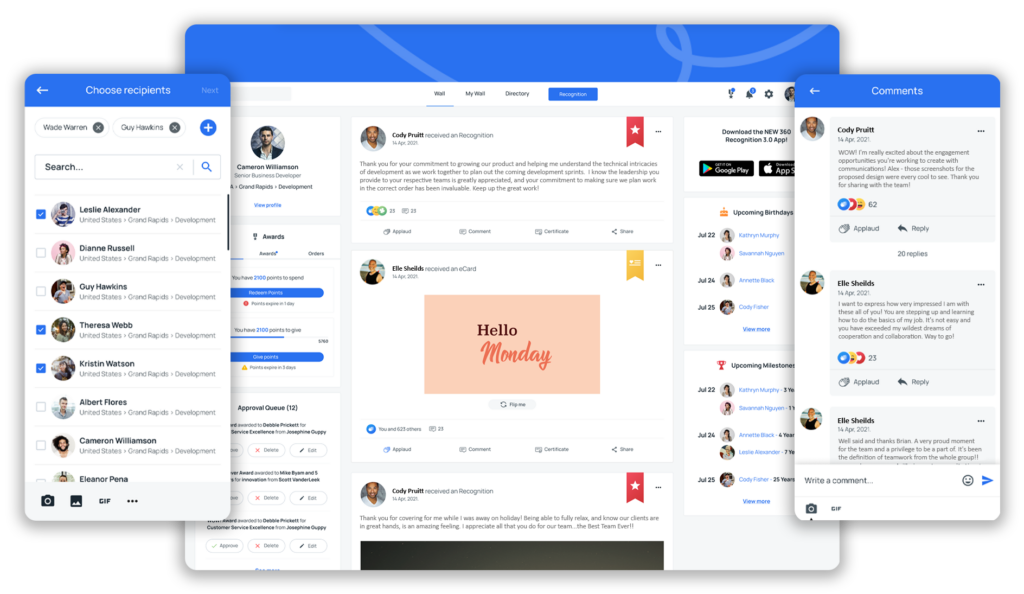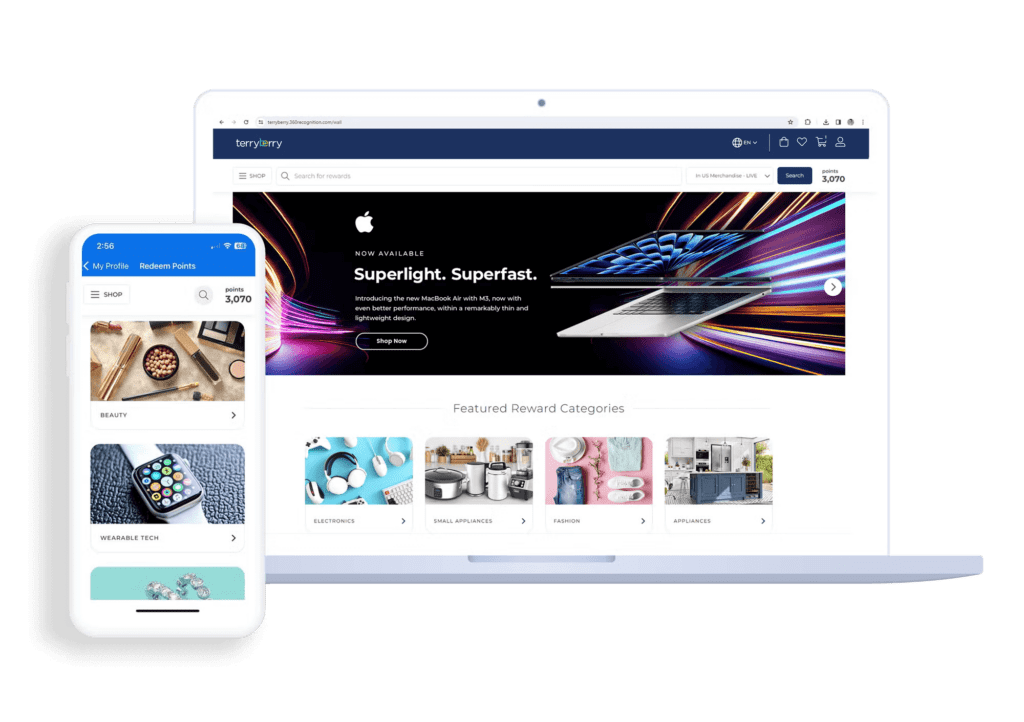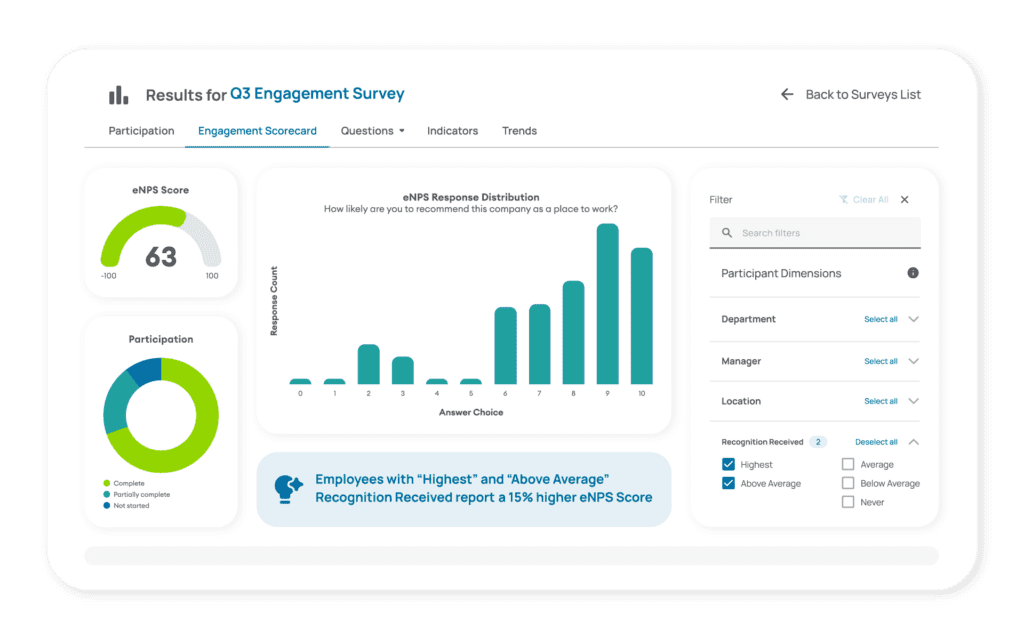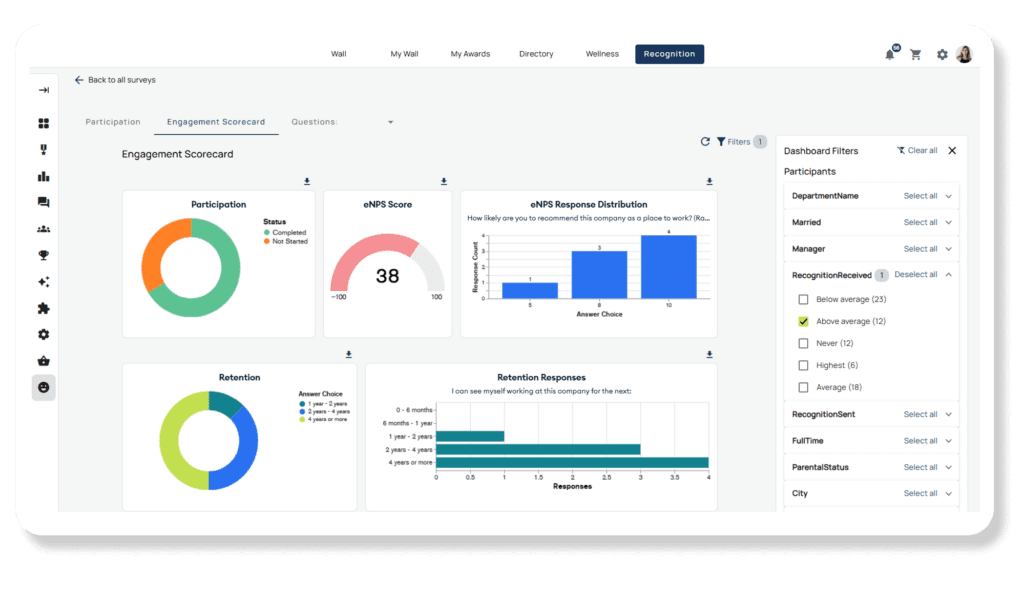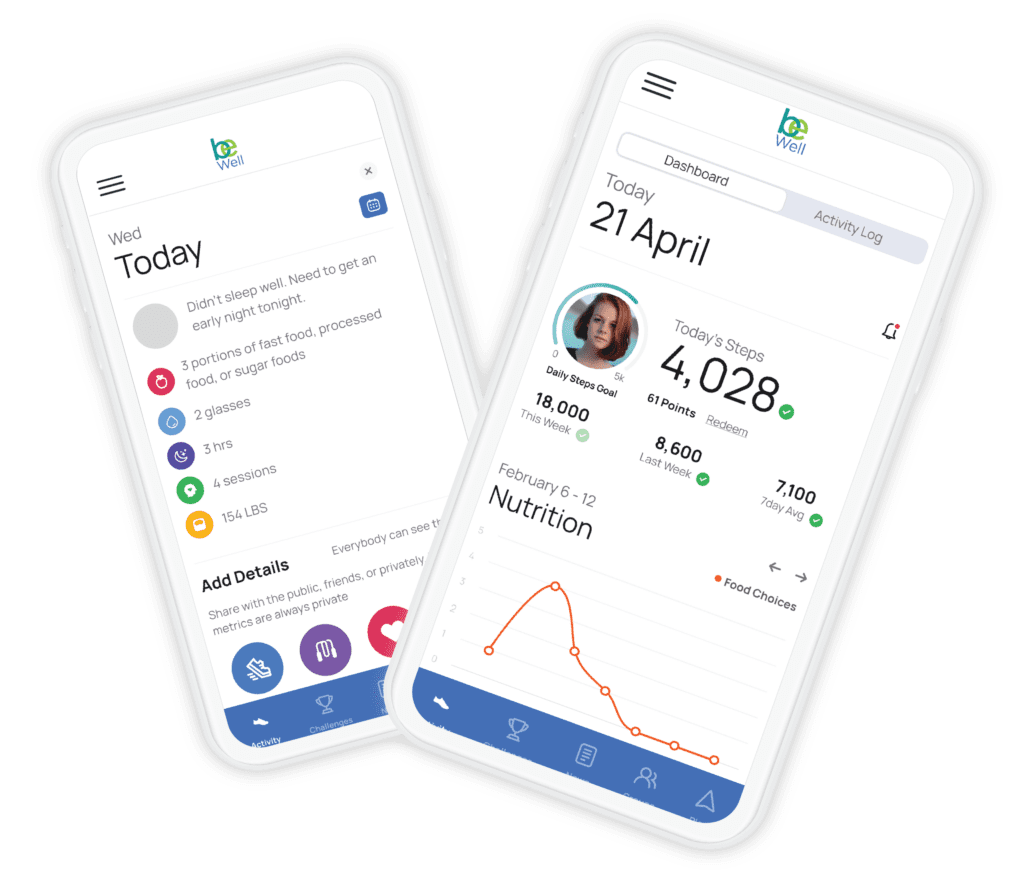September 29, 2025

When you’re shopping around for employee engagement software for healthcare, you’ll come across three types of vendors:
- Single-purpose platforms, such as standalone employee onboarding or listening tools.
- Vendors with different modules offered separately—such as one for HCM, another for recognition or internal comms, etc.
- Tools that integrate different modules in a single platform.
Healthcare companies that approach us typically have really specific engagement objectives, such as increasing retention and reducing burnout. They’re drawn to the third category because they can use a single platform to:
- Measure and quantify engagement, and analyze trends across groups. For example, if you’re aiming to reduce turnover, an employee listening tool can reveal why people leave, which groups are more likely to churn, and whether certain roles (e.g., nurses vs. canteen staff) are more prone to burnout.
- Take action with engagement programs, such as wellness and recognition, tailored to specific objectives. For example, a milestone program to improve retention or a wellness program to help employees manage stress. Many healthcare organizations launch industry-specific award programs, such as the DAISY Award.
Single-purpose or modular tools offer these capabilities separately, which has two main drawbacks. Firstly, administrative work gets multiplied; each program requires managing records, user access, budgets, incentives, and more.
The second reason is limited analytics and disparate data sources, which directly impact your program’s success. For example, maybe you’re running recognition and wellness programs to improve retention, promote your organization’s core values, and reduce burnout.
Siloed data will tell you how many people are participating in any one program, but you can’t track, say, the impact of recognition on employee engagement and wellness, or vice versa.
We designed Terryberry’s employee engagement software to succeed where single-purpose and modular tools fall short. Our centralized platform offers healthcare providers all the tools they need to measure and quantify employee engagement, take action with tailored programs, and prove their impact.
Terryberry’s All-in-One Employee Engagement Software for Healthcare
Most of our healthcare clients use a combination of programs to engage their workforce, including various types of recognition, wellness, and employee listening programs. Their roadmaps broadly follow these stages:
- Starting with organization-wide recognition programs, such as milestone, peer, and manager recognition. These programs are tailored to organization-wide goals, such as boosting retention, promoting core values, or encouraging specific performance outcomes (e.g., taking on shifts).
- Identifying gaps and investigating microcultures using employee listening. After launching their initial program(s), they measure performance across specific segments, such as facilities, departments, floors, and professions. The companies use a combination of participation data and surveys (e.g., engagement, burnout, and eNPS surveys) to investigate why some groups are more engaged than others.
- Taking action with supplementary programs. Our customers typically launch additional programs to identify any gaps they uncover. For example, they’ll invest in an organization-wide wellness program to support employee well-being, or launch a milestone recognition program to boost first-year employee retention.
We designed Terryberry to help healthcare organizations develop and execute their roadmaps for driving engagement, with:
- Support for different employee engagement programs: Terryberry lets you launch tailored employee recognition, incentive, wellness, and listening programs. You can configure each program to your specific goals, such as improving retention, promoting core values, or celebrating workers’ years of service.
- Centralized analytics and insights from science-backed surveys: Terryberry combines the data from all your employee engagement programs, helping you accurately measure their performance and impact.
- The largest collection of rewards in the market: Motivate employees to participate and reward their contributions by adding meaningful, zero-markup rewards to your engagement programs.
- Complete visibility into budgets and reward spends: Many healthcare organizations have “ghost expenditures” on rewards throughout the year. For example, managers might pass on gift cards that no one’s tracking, or use some obscure budget to fund a retirement party. Terryberry tracks the budgets and expenditure across all your engagement programs in real-time, offering complete visibility into where money’s coming in and where it’s going.
- Various participation options: Busy workers can participate in your programs directly from their mobile devices by logging into Terryberry’s app or through MS Teams and Outlook. We also offer various offline participation and recognition options.
In the next three sections, we’ll show you how to:
- Configure and launch recognition programs tailored to your strategic objectives, using Terryberry’s employee engagement platform. We’ll take you through the configurations our healthcare customers use to promote core values, reduce turnover, celebrate nurses for outstanding patient care, etc.
- Build a business case for your engagement program(s) by measuring their performance and impact on healthcare employee engagement and retention. Terryberry’s centralized analytics and science-backed culture model provide all the data you need to prove your program’s impact to leadership.
- Continuously improve your engagement strategy by identifying gaps and taking action with supplementary programs, including employee wellness initiatives. We’ll also share examples our customers have used to reduce burnout and improve retention.
Setting Up Your Goals-Driven Employee Recognition Programs
With Terryberry’s recognition platform, you can configure:
- How people are recognized, including for essential milestones, patient feedback, demonstrating core values, or specific actions like taking extra shifts. You can give managers budgets to distribute at their discretion, for on-the-spot recognition, and even allow workers to recognize their peers.
- What people are recognized for. For example, you can tie employee recognition to performance and core values, ensuring managers and peers recognize each other for the right reasons. You can also create “recognition levels,” where employees get points corresponding to the tier of recognition they receive.
- The rewards they receive. Create unique shopping experiences for your team by combining different reward categories, including merchandise, travel, charitable gifts, and experiences. You can also add program-specific rewards, such as custom trophies or plaques for awards programs, or fitness and wellbeing gifts for your wellness program.
Up next, we’ll take you over:
- The different recognition programs that healthcare organizations use to achieve their strategic objectives, including manager, milestone, and peer recognition.
- How we adapt engagement programs to support different groups of employees with their own micro-cultures.
- The types of incentives you can include in your engagement program using Terryberry’s rewards platform.
1. Manager Recognition Programs: Lay a Strong Foundation for Recognition
In our experience helping thousands of companies scale their employee engagement programs, leadership involvement has consistently proven to be a success factor across industries, regions, and company sizes. Healthcare’s no different—the most impactful programs are driven by managers and senior leaders, whether they’re recognizing people for day-to-day contributions and achievements or handing out awards during service anniversaries.
With Terryberry’s employee recognition software, you can allocate budgets (e.g., monthly or quarterly) for managers to invest in recognizing their team members. If you’re using Terryberry’s points-based rewards system, you can convert these budgets into points for managers to allocate.
Now, when a manager sees an employee demonstrating core values, picking up extra shifts, or going above and beyond in their work, they can allocate points and publicly recognize the employee in Terryberry’s engagement platform:
For example, sharing a spotlight on outstanding patient feedback is a common form of on-the-spot recognition in healthcare. When managers receive really exceptional feedback about one of their nurses or caregivers, their first instinct is to share it with the whole organization.
With Terryberry’s recognition program, managers can upload a picture of the feedback, recognize the employee it’s for, and broadcast the moment for everyone to see.
2. Milestone Recognition Programs: Increase Retention and Loyalty
You can configure custom milestones in Terryberry’s recognition software, ranging from personal milestones, such as birthdays or marriage, to work-related ones, like years of service anniversaries, and industry-related awards, like the DAISY.
Terryberry automates predictable milestones, such as years of service or birthdays, by extracting employees’ birthdays and tenure from our HRIS integrations. People can log in to Terryberry and view upcoming milestones, and receive reminders and notifications on MS Teams and Outlook.
If you’re looking to implement healthcare industry-specific awards, such as the DAISY, then you can customize nomination and approval workflows using Terryberry’s recognition software. For example, you can create:
- A nomination workflow that allows managers, peers, or both to nominate a colleague for an award. You can add custom criteria for the nomination and require people to specify why they’re putting someone forward for it.
- Approval workflows for both nominations and final selections. For example, managers can approve the initial nominations, while a committee of senior practitioners or executives can decide who receives the award(s).
For driving retention specifically, service award programs are one of the most effective milestone programs. For example, you might celebrate employees’ tenures at the 1, 3, 5, 10, and 15-year marks. These programs work exceptionally well when you:
- Involve leadership. Showing people they’re valued by senior leadership goes a long way in making them feel connected to the organization. You can engage different levels of leadership in various ways depending on the service anniversary. For example, maybe employees receive:
- First year: A personalized note of appreciation from their department head.
- Third year: A ceremony where they receive an award (such as a customized trophy) from senior leadership.
- Fifth-year: An invitation to dinner with the company’s senior leadership.
- Acknowledge the person’s contributions and achievements. Have they received outstanding patient feedback this year, been recognized for demonstrating specific core values, or reached specific performance goals?
- Include meaningful rewards. For example, you could include engraved plaques, personalized trophies, or customized jewelry. Some healthcare organizations we’ve worked with award people points on their anniversaries, which they can redeem for their preferred rewards using Terryberry’s rewards system.
We’ve helped our customers improve retention by launching programs founded on these principles, achieving results such as an 85% retention rate amongst frontline employees with 10+ years of service.
One of our health services clients with over 13,000 employees increased their first-year employee retention rate by 50% with a more niche milestone program. Like many healthcare services companies, the client experienced a high first-year voluntary turnover rate among caregivers. Nurses didn’t feel connected to the company, so they’d rack up some experience on their CVs and resign at the 1-year mark.
In this case, a year of service awards program wouldn’t help new hires because they were leaving by their first anniversary. Instead, we helped the company by launching a custom milestone program specifically for new hires. The program engaged new employees and connected them to the company’s culture throughout their first year, with milestones for the first day, week, and month, as well as 30 days, 90 days, and six months.
The custom milestone program reduced voluntary turnover by 50% amongst employees with up to 1 year of service.
3. Peer Recognition Programs: Empower Your Employees
Peer recognition programs transform regular employees from bystanders to champions of your program, because they’re no longer just on the receiving end of recognition. Like managers, they’re now also responsible for publicly recognizing their peers’ contributions and achievements.
If you’ve already laid a solid foundation using leadership-driven programs, peer-to-peer recognition can amplify their impact. For example, larger organizations with multiple locations that we’ve worked with find peer recognition particularly effective for maintaining their strong culture as they scale. People can see and celebrate their peers' contributions across different branches, creating a shared sense of purpose.
Just like how you can give managers points to spend on their team, you can allocate a budget for your peer recognition program and specify points for nominations.
For example, we created custom nominations tied to specific core values for Tidelands Health, a health services provider with over 2,500 employees. The company’s employees—regardless of their department, profession, or seniority level—can recognize their peers for demonstrating any of the core values, which are: people, service, quality, safety, finance, and growth.
When employees recognize each other, the special moments are displayed in the shared “culture hub” for everyone to see. Depending on your configurations, managers and/or other employees can also “boost” posts to award the recipient extra points.
Read more: How Tidelands Health increased employee engagement by 9% in its first year of launching multiple recognition programs with Terryberry.
4. Increase Participation and Engagement by Supporting Micro-Cultures
Especially for larger healthcare organizations, it’s common to have some groups with lower participation numbers in your program. For example, employees from a specific floor, department, or facility may participate less than others. Maybe canteen staff participate less than nurses, or vice versa.
In these situations, we’ll help you investigate the cause. Sometimes, the reason is quite straightforward—maybe the team just has a manager who doesn’t participate much in the program, impacting the whole group.
At other times, though, it may be due to the unique needs of the particular group. For example, the criteria for earning recognition may favor nurses over cleaning staff.
When you’re confronted with gaps in your existing program, you have two options:
- Update the program to address every group’s needs: This only works if you can manage a one-size-fits-all program that meaningfully caters to your entire workforce.
- Launch supplementary programs to support minority groups. If 4 out of 5 facilities or departments are engaged in your program and benefiting from it, it might be best to leave that program as is. You can configure a smaller, tailored recognition program for the fifth facility/department.
The right option depends on the circumstances, but we often find that larger organizations benefit from the second approach. For healthcare organizations in particular, it’s common to find groups with their own microcultures. Maybe one floor has its own bulletin board for nominating and recognizing people, or one facility prefers offline recognition options to online.
5. Choose the Right Incentives for Your Programs
We’ve integrated Terryberry’s rewards system into our broader engagement platform. This means you can add incentives to your programs, create custom shopping portals, and track budgets and orders in one place.
We offer three categories of rewards:
- Custom awards: Terryberry has proudly manufactured heritage awards for over a hundred years. Our custom plaques, trophies, and jewelry are a popular choice for milestone awards and performance programs.
- Terryberry X Amazon Business: Our integration with Amazon Business brings you the largest selection of rewards in the U.S. market, with zero markup and Prime-like delivery.
- Terryberry’s Premium Rewards catalog: You can create custom shopping portals by adding different categories from our Premium Rewards catalog, ranging from electronics to travel and lifestyle rewards, once-in-a-lifetime experiences, charitable donations, and merchandise.
People can redeem their preferred awards by logging onto Terryberry’s engagement platform via desktop or our mobile app. We also support offline workers with code-based redemption.
Building a Business Case: Measure Your Engagement Programs’ Performance & Impact
You can measure the performance of your different programs using participation data provided by Terryberry’s engagement platform. For example, you can track:
- Overall program participation, i.e., the percentage of your total eligible employees who have participated in the program.
- Participation by specific cohorts, such as the participation rates of specific departments, age groups, or individuals with a particular tenure.
- The groups of most and least engaged participants, such as your most and least recognized employees.
- Manager participation, such as which managers have given the most recognition.
- Points allocation. This metric offers a different perspective on participation. For example, let’s say five managers in specific facilities or departments use 100% of the points allocated to them for the month. Awarding all their available points means that enough employees participated in your program (e.g., by demonstrating core values) in the month to consume the full budget.
Participation metrics are a good, high-level indicator of how successfully your programs are driving strategic objectives. But they don’t demonstrate the impact of these programs on employee engagement and retention across different groups. For example, you can’t accurately measure the impact of:
- Manager participation on employee engagement and retention
- Your wellness program on employee well-being and turnover
- Recognition on retention and people’s connection to your company culture
Capturing these insights requires combining your program’s participation data with another layer of insights—collected from employee listening. Here’s how that works.
Combining Participation Stats with Employee Listening Data
Let’s start with a simple example of how you can measure the impact of recognition on retention by combining recognition analytics with eNPS data. All you need to do is run eNPS surveys, and Terryberry will combine the results with your recognition program’s participation stats in a single, centralized analytics dashboard:
With these combined insights, you can measure:
- eNPS scores of your most and least recognized employees
- eNPS scores of teams whose managers frequently give out recognition and teams whose managers don’t
Similarly, adding data from different surveys or even other programs (such as wellness) reveals deeper insights into the impact of your programs.
For example, our science-backed engagement baseline survey helps you track the impact of your program(s) on employee engagement across different cohorts. The baseline survey, backed by I/O psychologists, is based on Terryberry’s culture model.
We developed this model with the help of three independent PhD researchers to understand the cultural factors that collectively shape engagement across an organization.
The culture model defines six such engagement indicators: belonging, leadership, equity, purpose, empowerment, and well-being. Each indicator predicts how engaged employees are at work; for example, employees who rate their leaders as effective and empowering are 4x more likely to be engaged at work.
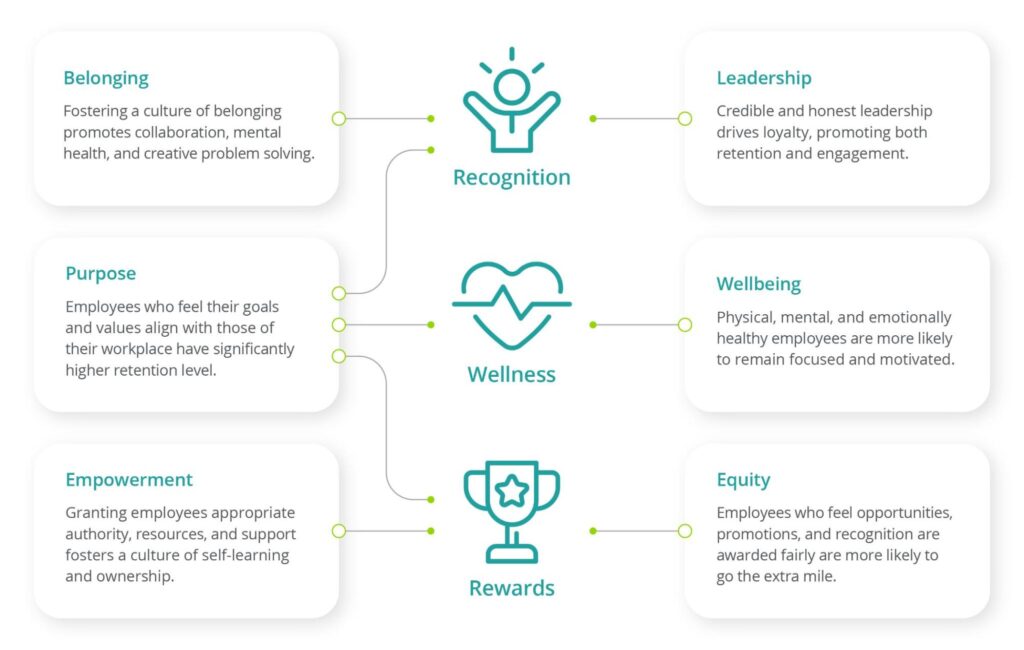
The baseline employee engagement survey measures and quantifies these indicators using a set of 38 questions. It returns a set of six Likert scores, which can be positive or negative, corresponding to each indicator.
For example, let’s say you survey nurses and the results show +20 in leadership and -3 in purpose scores. These responses indicate that nurses (i) have positive sentiments towards their managers, but (ii) aren’t aligned with your organization’s broader vision.
Combining these insights with participation metrics can help you track the impact of programs, such as wellness or recognition, on employee engagement. For example, you can compare the engagement indicator scores of:
- Your most and least recognized employees
- Top participants in your wellness programs vs. employees who haven’t participated at all
- Teams whose managers are highly participatory in your engagement programs vs. teams whose managers aren’t.
Let’s say two groups have the highest “purpose” and “belonging” scores: (i) your most recognized employees, and (ii) teams whose managers frequently give recognition. And your least recognized employees have significantly lower “purpose” and “belonging” scores. These results show the impact of your employee recognition program on people’s sense of belonging and purpose.
Now, if you combine these insights with eNPS data too, you can measure the impact of recognition on specific indicator scores and their subsequent impact on retention.
Continuous Improvement: Identify Gaps in Your Culture and Take Further Action
Terryberry’s unified analytics and employee listening data don’t just help you measure your program’s effectiveness. You can also use them to identify gaps in your program and overall workplace culture. There are two types of gaps to look for, related to:
- Participation: When you’re analyzing program participation data, check to see if any specific groups are less participatory. For example, maybe older employees are less participatory in a physical wellness challenge, or canteen workers are hardly recognized.
- Employee engagement: The baseline survey reveals the strengths and weaknesses of your workplace culture. Low and negative scores reveal opportunities to boost engagement by addressing the underlying gaps.
Terryberry helps you uncover trends specific to different cohorts using our participant filters:
You can filter by seniority level, tenure, job title, department, age group, gender, most and least recognized, etc., to compare participation, engagement indicator scores, and eNPS across groups. Mixing and matching different filters can reveal more niche, actionable insights, for example:
- Using the “tenure” filter to compare eNPS and indicator scores for employees with various years of service (1,3,5,10, etc.). For example, maybe employees with 5 years of tenure score lower in “equity” and “empowerment” but higher in “leadership” and “belonging,” compared to employees with 3 years of service.
- Using the “job title” filters in combination with “most and least recognized” filters to see if the impact of recognition differs across these groups.
For example, let’s consider the example above where your recognition program is positively impacting “purpose” and “belonging.”
The baseline survey can return some negative scores, too—e.g., your “well-being” and/or “empowerment” could be worse for your most recognized employees than those least recognized. You can investigate the cause of these gaps using additional, ready-made surveys from Terryberry’s library. For example, you can find out:
- The cause of a low employee well-being score using our well-being drill-down engagement survey and burnout surveys. You can supplement your findings by talking to the impacted groups/teams/departments’ leaders.
- The cause of a low equity score using the equity drill-down engagement survey and relevant employee satisfaction surveys.
Your findings inform which courses of action to consider next. For example, we discuss how organizations can investigate the causes of employee burnout and take action in the next section.
Reducing Burnout and Improving Employee Well-being
Burnout and low employee well-being are persistent challenges across the U.S. workforce, and healthcare staff in particular are suffering disproportionately. Many organizations struggle to identify the root causes—especially more niche ones—which makes it difficult to take action.
For example, after a few months of launching their recognition programs, some of our customers encounter a decrease in well-being scores amongst their “most recognized” employees. They’re usually surprised by this outcome, especially since their programs are designed to support people and promote core values.
But in this situation, the culprit isn’t straightforward. The cause is usually related to how employees’ responsibilities change over time. As high-performing employees are increasingly recognized for their contributions, they’re asked to take on more responsibility. Over time, these responsibilities weigh them down—they lose passion, feel more drained, and their overall well-being suffers.
Companies don’t anticipate this outcome because it’s almost counterintuitive to think that recognizing someone’s efforts could contribute to burnout. But there’s a logical change that leads to it. When companies realize the cause, they might consider several courses of action, including:
- Working with employees to plan out their career paths in the organization, helping them take on responsibilities they’re better suited for and passionate about.
- Preparing employees for new roles and responsibilities with additional training and support.
- Helping employees manage workplace stress, expectations, and work-life balance with personalized mental health plans and expert-led training seminars. You can launch these initiatives via Terryberry’s Be Well platform.
Evolving responsibilities is far from being the only cause of burnout, though. Various factors contribute to burnout across different organizations, including inefficient shift scheduling, limited support in the workplace, and rigid policies.
Many workers may also struggle with challenges unrelated to their workplace, such as mental health, sleep deprivation, and difficulty in managing stress and work-life balance. What’s most important is to uncover the factors contributing to burnout in your organization, specifically.
We help organizations proactively address employee well-being by (1) identifying the relevant factors negatively impacting different groups, and (2) taking action, which may include launching initiatives with Terryberry’s Be Well platform.
Be Well lets you launch various initiatives to support employees’ physical, mental, and workplace well-being. You can use Terryberry to:
- Design custom, gamified challenges: Choose from a range of challenges to support healthy habits. You can configure step and activity, hydration, heart rate, and sleep challenges, and create your own custom one with tailored goals from scratch.
- Support employees with personalized well-being plans: We provide plans tailored to your workers’ specific needs, such as reducing stress, managing work-life balance, or taking preventative steps to avoid burnout.
- Provide expert-led training: Tap into Terryberry’s wellness library that includes over 150 expert audio guides across 40+ mental health topics, on demand. You can also schedule expert-led trainings to support people with persistent challenges they’re facing.
- Detailed analytics: Just like with our Recognition Analytics, you can use Terryberry’s Wellness Analytics to track participation numbers and monitor progress across different challenges. You can also analyze trends specific to different cohorts, and Terryberry centralizes the data across your wellness, recognition, and listening programs.
Get Started with Terryberry’s Employee Engagement Software for Healthcare
Healthcare organizations and their workforce play a vital role in uplifting society, providing essential care and supporting people’s well-being. When healthcare workers are supported, valued, and engaged, they do their best work, ultimately benefiting all of us.
Terryberry gives healthcare organizations all the tools they need to measure, quantify, and drive employee engagement. We’ll work with you to design and scale engagement programs tailored to your strategic objectives, such as improving retention, reducing burnout, or promoting your organization’s core values.
Terryberry’s centralized analytics offer the most comprehensive insights into your program’s impact on employee engagement across different groups. Schedule your demo today to start building a highly engaged healthcare workforce.
